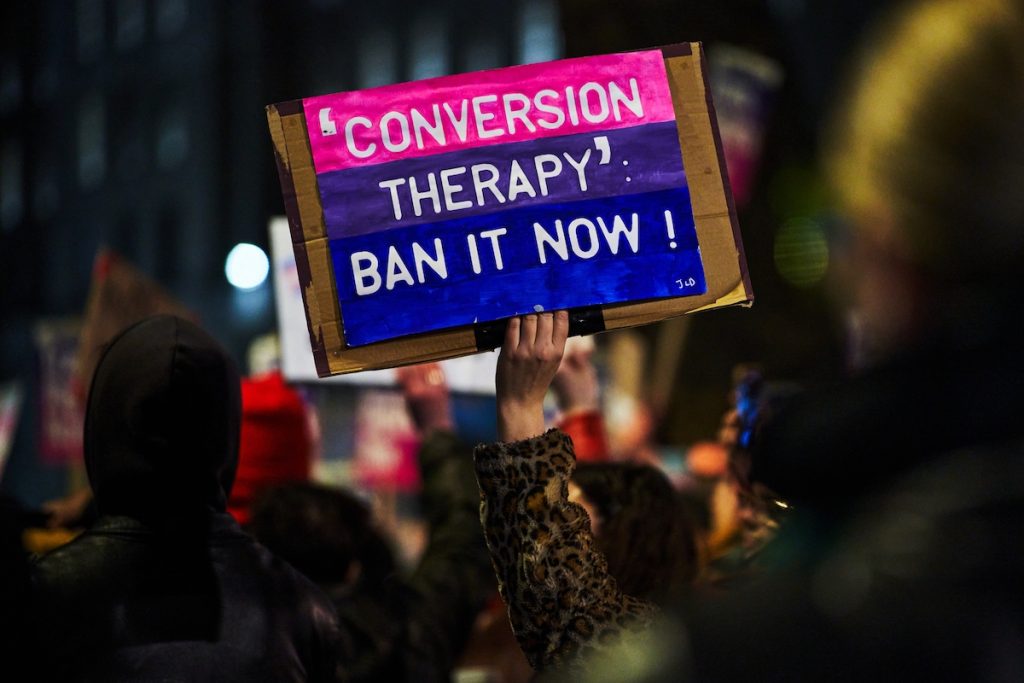
Conversion practices (CPs) through formal and structured means, attempt to suppress, change or subvert a person’s sense of their sexual orientation identity, gender identity, or both. Not all conversion practices occur at the hand of faith-based institutions, but within the hands of psychological, mental and physical health professionals across varied institutions and contexts within the UK and US where it remains legalised.
The PRIDE study, published recently in The Lancet Psychiatry, provided the data by means of a national, and long-term cross-sectional study. This study aimed to take a closer look at mental health outcomes (MHOs) across the intersections of gender and sexual orientation identities (or a combination of) within the LGBTQIA+ community with or without a recalled experience of CP. This study incorporated a battery of self-report psychometric tools alongside contextual and intersectional questions taken at two time-points. The specific MHOs focused on were the experiences of anxiety, depression, post-traumatic stress and suicidality (Tran et al., 2024). Keeping in mind the LGBTQIA+ acronym may not include all gender or sexual minorities (GSM), I will use GSM throughout this blog to incorporate all identities as done so in the study.
Contextually, this study is relevant for psychological professionals practising in the UK to reflect upon, as this year we have seen the UK Council for Psychotherapy (UKCP) withdraw their signature from the Memorandum of Understanding on Conversion Therapy in the UK (MoU) and its membership from the Coalition Against Conversion Therapy (CACT). There have been many promises made between UK governments old and new, around banning CPs. Many LGBTQIA+ organisations internally cite the unethical and harmful effects upon a marginalised community.

Conversion practices remain legalised in the UK and US and can be delivered by psychological, mental and physical health professionals despite associated harms.
Methods
Recruitment for this cohort study took place via social media, digital advertising and GSM community-related events. While the PRIDE study is long-term, this cross-sectional study focused on participants who completed a lifetime questionnaire in 2019-20 (T1) and an annual questionnaire in 2020-2021 (T2), with no missing data. English-only questionnaires were provided which took approximately 45 minutes to complete at each time point (Tran et al., 2024).
Mental health outcomes were measured by the incorporation of the Generalized Anxiety Disorder (GAD-7) 7 item scale, the Patient Health Questionnaire 9 item (PHQ-9) scale, the PTSD checklist 6-item (PLC-6) scale, and the Suicide Behaviors Questionnaire-Revised (SBQ-R). All statistical analyses were completed in R (V4.3.1), sensitivity analysis with the sensemakr tool (Tran et al., 2024).
Linear regression analysis via Huber-White sandwich estimator was used to account for standard errors around potential violations of assumptions regarding the variances of the outcomes. Linear regressions were used to examine the relationship between recall of CP and mental health symptoms (MHS) controlling for demographic and childhood factors. Demographic factors included age, ethnicity, education level, while childhood factors looked at the presence or absence of MHS, or of a religious upbringing, community acceptance or non-acceptance of GSMs, and geographical region via Census division. Prospective confounders identified in the current literature were discussed in the study. Model fit could then be assessed using metrics like r², adjusted r², Akaike information criterion, and Bayesian information criterion. The proportion of missing covariate data was minimal (0.1%-0.2%), and mice package use allowed for multiple imputation by chained equations. This created 20 imputed datasets to address the aforementioned missing data. Groups were then created to compare cisgender and transgender/gender diverse participants. Results were then reported as “unstandardized β” which accounted for the mean differences in scores between participants who did and did not recall CPs. Alongside 95% confidence interval (CI), result evaluation focused the estimates in the areas of direction, precision of estimates and magnitude (Tran et al., 2024).
With such a large and varied sample size, sensitivity analysis was performed to assess for potential unmeasured confounders which could occur if mental health symptoms were experienced that pre-date the exposure to conversion practices (CP). Creatively, this study used the Cinelli and Hazlett approach to estimate the potential strength of mental health symptoms that pre-date CP using religious upbringing and being raised in a community that does not accept GSMs; two covariates to hold in mind. This was done to capture the presence of a structural cisheterosexist environment that shapes mental health outcomes prior and post-CP exposure. Three scenarios were considered (Tran et al., 2024):
- An equal variation to the covariates.
- Twice the amount of variation.
- Three times the amount of variation.
This led to the partial r² value as a result of adjusting estimates, application of a 95% CI, and robustness value with its lower bound (smallest value that would round up to estimated) (Tran et al., 2024).
Results
6,601 participants completed T1 and 4,440 completed T2, a further 14 participants were excluded due to missing data in their questionnaires, 4,426 total participants were included. 92% of total participants identified themselves as White, 6.% as Hispanic, Latino or Spanish, 4.9% as Asian, and 3.3% as Black, African-American or African. Other ethnoracial identities included American-Indian or Alaska native (2.7%), Middle Eastern or North African (1.3%), Native Hawaiian or other Pacific Islander (0.2%), and unspecified (1.2%). 56.6% participants identified themselves as cisgender, and 43.4% as transgender or gender-diverse. The median age of participants was 31.7 years, with the total range stretching from 18 to 84 years. 88.2% of participants reported not experiencing homelessness, and the majority represented education level was a 4-year degree (35.2%).
Most participants reported experiencing a religious upbringing that rejected SGM communities (60.8%), while a staggering 77.6% of participants reported that they were not raised in a SGM-accepting community. 5.4% of the sample were exposed to CPs, with 3.4% exposed to sexual orientation only (SO), 1% to gender identity (GI) only, and 1% were exposed to both CPs. Sexual orientation only CPs were most commonly provided by faith-based leaders or organisations (52.4%) and then by mental health professionals or organisations (29%). Critically, 54% of CPs aimed at gender identity were provided by mental health providers or organisations, and 33% by faith-based leaders or organisations.
In terms of mental health outcomes, the entire GSM sample captured a mean GAD-7 score of 7.4 and a PHQ-9 score of 8.0 meeting the threshold of mild anxiety and depression (Ruiz et al., 2011; Kroenke et al., 2001). Significantly and thematically, the mean PLC-6 score was 14.0 indicating an increased risk for post-traumatic stress, while the SQB-R score mean of 8.7 indicated moderate risk for suicidality (Han et al., 2016; Osman et al., 2001). These results offer a numerical representation of the impacts of CPs on an already marginalised population with many intersections. Pre-adjusted models, those who had experienced CP for gender identity only scored the highest in measures of anxiety, depression and PTSD-related symptoms, with the highest level of suicidality recorded among those who recalled CPs for both gender identity and sexual orientation. Following adjusted models, recall of sexual orientation only (SO) was associated with higher reported PTSD symptoms and suicidality. While gender identity only (GI), was associated with symptoms of depression, PTSD and suicidality. Recall of experiencing both GI and SO, was even more greatly associated with symptoms of depression, PTSD and suicidality.
Transgender/gender-diverse participants appeared to experience greater mental health symptoms when compared to cisgender participants. Greater mental health symptoms were reported when recall to CP exposure was recorded among all participants, estimated associations across mental health outcomes were similar between cisgender and transgender/gender-diverse participants. Suicidality was more greatly associated to CP exposure for both gender identity (GI) and sexual orientation, and less precise association was recorded for GI only.
Robustness of unmeasured confounders was reported to be moderately robust, in other words, the sensitivity analysis aiming to attend to unmeasured confounders was reasonably effective as equivalent to the observed covariates of a religious upbringing and being raised in a non-accepting of GSM community. It is possible through this lens if assumed to be equally strong, that the observable estimates of this study cannot be dismissed, and that there is moderate explanatory power sufficient within the two observable estimates.

Lived experience of both gender identity and sexual orientation conversion practices was associated with higher levels of depression, PTSD and suicidality.
Conclusions
This study clearly spoke to the prevalence of conversion practice (CP) exposure across gender or sexual minority (GSM) participants and supported the available evidence to date. Suicidality remained the area of difference among cisgender and transgender/gender-diverse groups, with cisgender participants reported greater associations when exposed to CPs for both gender identity (GI) and sexual orientation (SO). While this finding is not clearly understood, the authors held in mind the possibility of survivorship bias, that the voices of those who are no longer alive cannot be incorporated. They also alluded to accessibility and access to social and financial support, which may mean this sample does not encompass all intersectional experiences (proportionate ethnoracial representation, wealth, education, homelessness, and so on) (Tran et al., 2024).
In a striking way, this study identified CPs aimed at gender identity were facilitated mostly by mental health professionals or organisations in the US (54%), while the majority of sexual orientation CPs were facilitated by faith-based leaders or organisations (52%). It is both sombre and devastating to see not only a numerical representation of the mental health symptoms and harms experienced by individuals from gender or sexual minorities in the US, but that some of this harm is being inflicted by the very people visited to provide the opposite outcome.
Types of CPs were discussed, ranging from exorcisms to medication or talking therapy, which the authors hypothesised could worsen mental health outcomes, specifically in the context of self-hatred and impairing positive identity formation. Ultimately, Tran et al. (2024), concluded that conversion practices pose a significant threat to public health, increasing the harm upon individuals from gender or sexual minorities and creating an ethical quandary around who they can turn to safely to unpack these experiences.

Transgender and gender-diverse people who experienced conversion practices appeared to experience greater mental health symptoms compared to their cisgender counterparts.
Strengths and limitations
This study very significantly assisted in making the invisible visible; using statistically robust and honest efforts to quantify the unmeasurable confounders when we look at a lifetime questionnaire conducted many years (in some cases) after CP. The roadblock of measuring the unmeasurable – going back in time to look at confounders, has been an obstacle to building the evidence base around adverse experiences of marginalised communities. This study attended to that roadblock exceptionally well, and for the first time provided hope around quantification of an oppressed and suppressed group of people subjected to conversion practices. It additionally demonstrated that a religious upbringing and non-accepting attitudes towards the GSM community can explain some of the observed associations, although further studies are needed to explore the residual confounding. The authors suggested family rejection may cover some of this residual confounding. It is critical to hold in mind how painful, subjective and nuanced rejection can feel.
An additional statistical limitation may be the presence of selection bias, named by the authors, as those who may have been most severely impacted by CP may not have been included. While the authors note that white participants are the majority represented in this sample, more can be done at recruitment to amplify ethnoracial-marginalised voices.
To complete a 45 minute survey two consecutive years in a row around an extremely distressing and painful experience, is quite a big ask. This is particularly true if that traumatic experience remains painful, and where trust in mental health professionals does not feel possible. Notwithstanding the accessibility obstacles faced by those without financial means to access this website or those who may not find it possible to remain in the same position for 45 minutes. Accessibility of this questionnaire in addition to questions aimed at the intersection of GSM and ability or neurodivergence mean that a proportion of the national LGBTQIA+ community are lacking a voice.
Regarding age, the study covers a broad range, and while there are ethical limitations to reaching under 18 populations, we have to hold in mind that some GSM individuals may be impacted by CPs at such a vulnerable chapter in their lives. Additionally, there can be many incarnations of GSM experiences, of which CP can paralyse the fluidity of, and add complexity when measuring retrospectively in this way. For example, a person may have experienced CP exposure at a time of identifying as cisgender and gay, but today they may identify within the gender-diverse community but their sexual orientation may remain the same. Conversely, the strengths of this paper in its dedication to represent varied and open demographic labels allowed for a clear view of GSM experiences and geographical dispersion across the US. Migration to more GSM accepting states and cities must be held in mind, further studies exploring this and mental health could be informative although immensely live to political swings.
I reflected on how it might feel to complete a lifetime (T1) questionnaire and remember to complete T2 the following year. While this strengthens the evidence base, I am curious about how participants were reminded of T2.
Contextually, the sample used in this study fell during the COVID-19 pandemic, and I am curious about how local and state-wide lockdown laws may have impacted on grassroots recruitment efforts.
A prospective unmeasured confounder could be the presence of more informal CPs, while they may be less structured, long-term exposure can be eroding and perpetuate internalised shame either alone or in tandem with formal CPs (Jones et al., 2022). Such informal CPs as graduated isolation from affirming peers, accountability circles or support groups which perpetuate cis heteronormativity, social stigma either in conservative states or micro-communities nationally. This came to mind as I reflected on my lived experience of brief formal CP and informal longer-term CPs while living in the US. I wondered what kind of support I would need before, during and after this questionnaire and thought about the strong sample size of paired measures. Could it be that a greater sample would be recruited if some containment could be offered alongside?
Further to this, I thought about queer joy which holds many intersections and may be anecdotally hard to measure, and how this can feel radical while practices to amputate it continue to exist.

This study succeeded to quantify an oppressed and suppressed experience in the context of conversion practices within a marginalised community.
Implications for practice
This new evidence echoes and amplifies the existing evidence base in the context of poor mental health outcomes (MHOs) linked with conversion practice (CP) exposure. It is innovative at various points, firstly in the opportunity to compare cisgender and transgender/gender-diverse mental health within the sample. Secondly, the methods and statistical analyses actioned and harnessed by the authors provide hope around measuring the unmeasurable. Critically, in measuring the previously labelled “unmeasurable” i.e., experiential confounders of religious upbringings and being raised in a community that is non-accepting of GSM individuals, can actually be somewhat estimated. The greatest implication for practice following this study’s coherent and effective demonstration of poorer MHOs associated with CP exposure, is an ethical question. How long can mental health professionals and organisations, as well as governments, continue to offer conversion practices or sit on the fence despite the evidence?
Policies rarely address diverse cultural contexts and inequities, this in turn can feed systems of oppression that subvert change. Policy changes to attend to this, particularly focusing on marginalised ethnoracial communities or otherwise minoritised communities, effective and tangible safeguarding could be possible. Policies, wherever they are enacted in the world, require action and sustained effort that can withstand changes in government and negative narratives perpetuated by harmful intent.
A ban on conversion practices (CPs) is named as an important factor by the authors in addressing heterogeneity at federal, state and local levels. Education for families and religious leaders around CP risks, and trauma-informed care provided for survivors are small steps to attending to the harm inflicted. It does appear to be intersectionality unique to GSM communities that structural and formal CPs continue to exist, not all identities are sought to be subverted in the cold light of day.
This led me to reflect on shame and self-hatred, knowing I may fit into many of the represented statistics within this paper, which reminds me of the long road ahead. Of course, both can be true: we can experience queer joy while holding grief and shame on the other hand. Shame can be incredibly paralysing, isolating and emotionally corrosive. An antonym for shame is pride, and while shame takes time to untangle, these statistics from the aptly named PRIDE study can speak for those who are trying to find their voice. Coincidentally, I’ve always thought of pride in a moment or memory, this PRIDE study is long-term and will continue to grow with a view to name the unnamed or untold.

The ban of conversion practices is an important first step to address heterogeneity of mental health outcomes at federal, state and local levels.
Statement of interests
Vanessa is a Trainee Clinical Psychologist in the UK and identifies as queer (they/them). Vanessa lived in the US for many years.
Links
Primary paper
Tran, N.K. et al. (2024) ‘Conversion practice recall and mental health symptoms in sexual and gender minority adults in the USA: A cross-sectional study’, The Lancet Psychiatry. doi:10.1016/s2215-0366(24)00251-7.
Other references
Han, B. et al. (2016) ‘Validation of a brief PTSD screener for underserved patients in federally qualified health centers’, General Hospital Psychiatry, 38, pp. 84–88. doi:10.1016/j.genhosppsych.2015.07.009.
Jones, T.W., Power, J. and Jones, T.M. (2022) ‘Religious trauma and moral injury from LGBTQA+ conversion practices’, Social Science & Medicine, 305, p. 115040. doi:10.1016/j.socscimed.2022.115040.
Kroenke, K., Spitzer, R.L. and Williams, J.B. (2001) ‘The PHQ-9’, Journal of General Internal Medicine, 16(9), pp. 606–613. doi:10.1046/j.1525-1497.2001.016009606.x.
Osman, A. et al. (2001) ‘The suicidal behaviors questionnaire-revised (SBQ-r):validation with clinical and nonclinical samples’, Assessment, 8(4), pp. 443–454. doi:10.1177/107319110100800409.
Ruiz, M.A. et al. (2011) ‘Validity of the GAD-7 scale as an outcome measure of disability in patients with generalized anxiety disorders in primary care’, Journal of Affective Disorders, 128(3), pp. 277–286. doi:10.1016/j.jad.2010.07.010.
